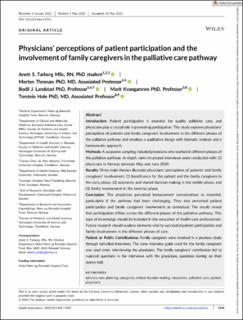| dc.contributor.author | Tarberg, Anett Skorpen | |
| dc.contributor.author | Thronæs, Morten | |
| dc.contributor.author | Landstad, Bodil | |
| dc.contributor.author | Kvangarsnes, Marit | |
| dc.contributor.author | Hole, Torstein | |
| dc.date.accessioned | 2023-02-14T15:25:50Z | |
| dc.date.available | 2023-02-14T15:25:50Z | |
| dc.date.created | 2022-07-07T11:06:55Z | |
| dc.date.issued | 2022 | |
| dc.identifier.citation | Health Expectations. 2022, 25 (4), 1945-1953. | en_US |
| dc.identifier.issn | 1369-6513 | |
| dc.identifier.uri | https://hdl.handle.net/11250/3050834 | |
| dc.description.abstract | Introduction
Patient participation is essential for quality palliative care, and physicians play a crucial role in promoting participation. This study explores physicians' perceptions of patients and family caregivers' involvement in the different phases of the palliative pathway and employs a qualitative design with thematic analysis and a hermeneutic approach.
Methods
A purposive sampling included physicians who worked in different phases of the palliative pathway. In-depth, semi-structured interviews were conducted with 13 physicians in Norway between May and June 2020.
Results
Three main themes illustrate physicians' perceptions of patients' and family caregivers' involvement: (1) beneficence for the patient and the family caregivers in the early phase, (2) autonomy and shared decision-making in the middle phase, and (3) family involvement in the terminal phase.
Conclusion
The physicians perceived bereavement conversations as essential, particularly if the pathway had been challenging. They also perceived patient participation and family caregivers' involvement as contextual. The results reveal that participation differs across the different phases of the palliative pathway. This type of knowledge should be included in the education of health-care professionals. Future research should explore elements vital to successful patient participation and family involvement in the different phases of care.
Patient or Public Contributions
Family caregivers were involved in a previous study through individual interviews. The same interview guide used for the family caregivers was used when interviewing the physicians. The family caregivers' contribution led to nuanced questions in the interviews with the physicians, questions leaning on their stories told. | en_US |
| dc.language.iso | eng | en_US |
| dc.publisher | Wiley | en_US |
| dc.relation.uri | https://onlinelibrary.wiley.com/doi/10.1111/hex.13551 | |
| dc.rights | Navngivelse 4.0 Internasjonal | * |
| dc.rights.uri | http://creativecommons.org/licenses/by/4.0/deed.no | * |
| dc.title | Physicians' perceptions of patient participation and the involvement of family caregivers in the palliative care pathway | en_US |
| dc.title.alternative | Physicians' perceptions of patient participation and the involvement of family caregivers in the palliative care pathway | en_US |
| dc.type | Peer reviewed | en_US |
| dc.type | Journal article | en_US |
| dc.description.version | publishedVersion | en_US |
| dc.source.pagenumber | 1945-1953 | en_US |
| dc.source.volume | 25 | en_US |
| dc.source.journal | Health Expectations | en_US |
| dc.source.issue | 4 | en_US |
| dc.identifier.doi | 10.1111/hex.13551 | |
| dc.identifier.cristin | 2037523 | |
| cristin.ispublished | true | |
| cristin.fulltext | original | |
| cristin.qualitycode | 1 | |

